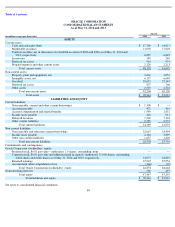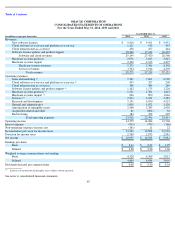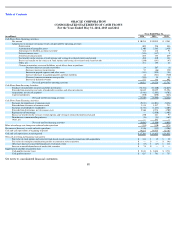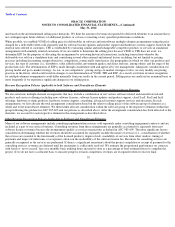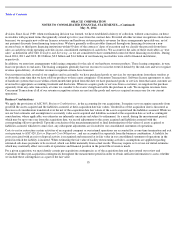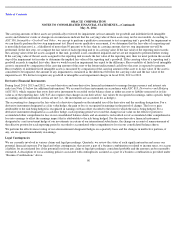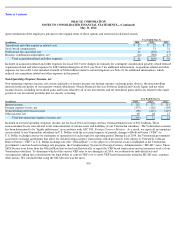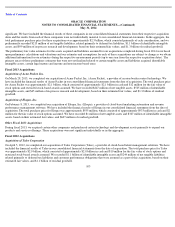Oracle 2013 Annual Report Download - page 97
Download and view the complete annual report
Please find page 97 of the 2013 Oracle annual report below. You can navigate through the pages in the report by either clicking on the pages listed below, or by using the keyword search tool below to find specific information within the annual report.
Table of Contents
ORACLE CORPORATION
NOTES TO CONSOLIDATED FINANCIAL STATEMENTS—(Continued)
May 31, 2014
unit based on the aforementioned selling price hierarchy. We limit the amount of revenue recognized for delivered elements to an amount that is
not contingent upon future delivery of additional products or services or meeting of any specified performance conditions.
When possible, we establish VSOE of selling price for deliverables in software and nonsoftware multiple-element arrangements using the price
charged for a deliverable when sold separately and for software license updates and product support and hardware systems support, based on the
renewal rates offered to customers. TPE is established by evaluating similar and interchangeable competitor products or services in standalone
arrangements with similarly situated customers. If we are unable to determine the selling price because VSOE or TPE does not exist, we
determine ESP for the purposes of allocating the arrangement by reviewing historical transactions, including transactions whereby the
deliverable was sold on a standalone basis and considering several other external and internal factors including, but not limited to, pricing
practices including discounting, margin objectives, competition, contractually stated prices, the geographies in which we offer our products and
services, the type of customer (i.e., distributor, value added reseller, government agency and direct end user, among others) and the stage of the
product lifecycle. The determination of ESP is made through consultation with and approval by our management, taking into consideration our
pricing model and go-to-market strategy. As our, or our competitors’, pricing and go-to-market strategies evolve, we may modify our pricing
practices in the future, which could result in changes to our determination of VSOE, TPE and ESP. As a result, our future revenue recognition
for multiple-
element arrangements could differ materially from our results in the current period. Selling prices are analyzed on an annual basis or
more frequently if we experience significant changes in our selling prices.
Revenue Recognition Policies Applicable to both Software and Nonsoftware Elements
Revenue Recognition for Multiple-Element Arrangements—Arrangements with Software and Nonsoftware Elements
We also enter into multiple-element arrangements that may include a combination of our various software related and nonsoftware related
products and services offerings including new software licenses, software license updates and product support, cloud SaaS, PaaS and IaaS
offerings, hardware systems products, hardware systems support, consulting, advanced customer support services and education. In such
arrangements, we first allocate the total arrangement consideration based on the relative selling prices of the software group of elements as a
whole and to the nonsoftware elements. We then further allocate consideration within the software group to the respective elements within that
group following the guidance in ASC 985-
605 and our policies as described above. After the arrangement consideration has been allocated to the
elements, we account for each respective element in the arrangement as described above.
Other Revenue Recognition Policies Applicable to Software and Nonsoftware Elements
Many of our software arrangements include consulting implementation services sold separately under consulting engagement contracts and are
included as a part of our services business. Consulting revenues from these arrangements are generally accounted for separately from new
software licenses revenues because the arrangements qualify as services transactions as defined in ASC 985-605. The more significant factors
considered in determining whether the revenues should be accounted for separately include the nature of services (i.e., consideration of whether
the services are essential to the functionality of the licensed product), degree of risk, availability of services from other vendors, timing of
payments and impact of milestones or acceptance criteria on the realizability of the software license fee. Revenues for consulting services are
generally recognized as the services are performed. If there is a significant uncertainty about the project completion or receipt of payment for the
consulting services, revenues are deferred until the uncertainty is sufficiently resolved. We estimate the proportional performance on contracts
with fixed or “not to exceed” fees on a monthly basis utilizing hours incurred to date as a percentage of total estimated hours to complete the
project. If we do not have a sufficient basis to measure progress towards completion, revenues are recognized when we receive final
93



